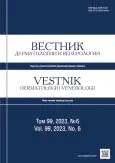Poikilodermic form of mycosis fungoides in a young patient with a good clinical response to UV therapy
- Authors: Burtseva N.Y.1, Melnikova T.V.1, Monakhov K.N.1, Sokolovskiy E.V.1
-
Affiliations:
- First Pavlov State Medical University of Saint Petersburg
- Issue: Vol 99, No 6 (2023)
- Pages: 53-60
- Section: GUIDELINES FOR PRACTITIONERS
- URL: https://bakhtiniada.ru/0042-4609/article/view/252157
- DOI: https://doi.org/10.25208/vdv13277
- ID: 252157
Cite item
Full Text
Abstract
The article presents a description of the poikilodermic form of mycosis fungoides in a young patient. At the time of presentation, the skin lesion had existed for about 4 years and was slowly progressing. A skin biopsy was performed with histological examination, based on the results of which a diagnosis of lichen sclerosus was established. Subsequently, the skin process progressed, and rashes appeared that were not typical for lichen sclerosus. There was an assumption that the patient had a poikilodermic form of mycosis fungoides. The diagnosis was confirmed after performing histological and immunohistochemical studies of a skin biopsy. General narrow-band mid-wave ultraviolet therapy was performed with good clinical results.
Full Text
##article.viewOnOriginalSite##About the authors
Natalia Yu. Burtseva
First Pavlov State Medical University of Saint Petersburg
Author for correspondence.
Email: burtsevaderm@mail.ru
ORCID iD: 0000-0003-1800-1610
Dermatovenereologist
Russian Federation, 6–8 Lev Tolstoy street, 197022 Saint PetersburgTatiana V. Melnikova
First Pavlov State Medical University of Saint Petersburg
Email: tatmel2007@yandex.ru
ORCID iD: 0000-0001-9983-0327
Dermatovenereologist
Russian Federation, 6–8 Lev Tolstoy street, 197022 Saint PetersburgKonstantin N. Monakhov
First Pavlov State Medical University of Saint Petersburg
Email: knmonakhov@mail.ru
ORCID iD: 0000-0002-8211-1665
MD, Dr. Sci. (Med.), Professor
Russian Federation, 6–8 Lev Tolstoy street, 197022 Saint PetersburgEvgeny V. Sokolovskiy
First Pavlov State Medical University of Saint Petersburg
Email: s40@mail.ru
ORCID iD: 0000-0001-7610-6061
SPIN-code: 6807-7137
MD, Dr. Sci. (Med.), Professor
Russian Federation, 6–8 Lev Tolstoy street, 197022 Saint PetersburgReferences
- Unna PGSF, Pollitzer D. Über die Parakeratosen im allgemeinen und eine neue Form derselben (Parakeratosis variegata). Monatschr Prakt Dermatol. 1890;10:404–412.
- Mahajan VK, Chauhan PS, Mehta KS, Sharma AL. Poikiloderma vasculare atrophicans: a distinct clinical entity? Indian J Dermatol. 2015;60(2):216. doi: 10.4103/0019-5154.152566
- Choi MS, Lee JB, Kim SJ, Lee SC, Won YH, Yun SJ. A case of poikiloderma vasculare atrophicans. Ann Dermatol. 2011;23(Suppl1):S48–52. doi: 10.5021/ad.2011.23.S1.S48
- Liu C, Tan C. 34 years’ duration of poikilodermatous lesion. Postepy Dermatol Alergol. 2020;37(3):438–440. doi: 10.5114/ada.2020.95966
- Kazakov DV, Burg G, Kempf W. Clinicopathological spectrum of mycosis fungoides. J Eur Acad Dermatol Venereol. 2004;18(4):397–415. doi: 10.1111/j.1468-3083.2004.00937.x
- Singh GK, Arora S, Das P, Singh V, Sharma V, Gupta A. A long journey of poikilodermatous erythroderma to poikilodermatous mycosis fungoides: a case report. Indian Dermatol Online J. 2022;13(5):663–666. doi: 10.4103/idoj.IDOJ_646_21
- Chairatchaneeboon M, Thanomkitti K, Kim EJ. Parapsoriasis-A diagnosis with an identity crisis: a narrative review. Dermatol Ther (Heidelb). 2022;12(5):1091–1102. doi: 10.1007/s13555-022-00716-y
- Белоусова И., Казаков Д., Самцов А. Лимфопролиферативные заболевания кожи. Клиника и диагностика. M.: ГЭОТАР-Медиа; 2022. C. 16. [Belousova I, Kazakov D, Samtsov A. Lymphoproliferative diseases of the skin. Clinic and diagnostics. Moscow: GEOTAR-Media; 2022. P. 16. (In Russ.)]
- Assaf C, Sterry W. Cutaneous lymphoma // Wolff K, Goldsmith LA, Katz SI, Gilchrest BA, Paller AS, Leffell DJ, eds. Fitzpatrick’s dermatology in general medicine. 7th ed. N.Y.: McGraw-Hill; 2008. P. 2154–2157.
- Kikuchi A, Naka W, Nishikawa T. Cutaneous T-cell lymphoma arising from parakeratosis variegata: long-term observation with monitoring of T-cell receptor gene rearrangements. Dermatology. 1995;190:124–127. doi: 10.1159/000246660
- Kreuter A, Hoffmamm K, Altmeyer P. A case of poikiloderma vasculare atrophicans, a rare variant of cutaneous T-cell lymphoma, responding to extracorporeal photopheresis. J Am Acad Dermatol. 2005;52:706–708. doi: 10.1016/j.jaad.2004.10.877
- Popadic S, Lekic B, Tanasilovic S, Bosic M, Nikolic M. Poikilodermatous mycosis fungoides with CD30-positive large cell transformation successfully treated by brentuximab vedotin. Dermatol Ther. 2020;33(1):e13152. doi: 10.1111/dth.13152
- Jeon J, Kim JH, Ahn JW, Song HJ. Poikiloderma vasculare atrophicans showing features of ashy dermatosis in the beginning. Ann Dermatol. 2015;27(2):197–200. doi: 10.5021/ad.2015.27.2.197
- Nikolaou VA, Papadavid E, Katsambas A, Stratigos AJ, Marinos L, Anagnostou D, et al. Clinical characteristics and course of CD8+ cytotoxic variant of mycosis fungoides: a case series of seven patients. Br J Dermatol. 2009;161(4):826–830. doi: 10.1111/j.1365-2133.2009.09301.x
- Citarella L, Massone C, Kerl H, Cerroni L. Lichen sclerosus with histopathologic features simulating early mycosis fungoides. Am J Dermatopathol. 2003;25(6):463–465. doi: 10.1097/00000372-200312000-00002
- Schiller PI, Flaig MJ, Puchta U, Kind P, Sander CA. Detection of clonal T cells in lichen planus. Arch Dermatol Res. 2000;292(11):568–569. doi: 10.1007/s004030000178
- Nofal A, Salah E. Acquired poikiloderma: proposed classification and diagnostic approach. J Am Acad Dermatol. 2013;69(3):e129–140. doi: 10.1016/j.jaad.2012.06.015
- Белоусова И.Э. Одновременное выявление Т- и В-клеточной клональности при пойкилодермической форме грибовидного микоза. Гематология и трансфузиология. 2007;52(5):45–46. [Belousova IE. Simultaneous detection of T- and B-cell clonality in the poikilodermic form of mycosis fungoides. Hematology and transfusiology. 2007;52(5):45–46. (In Russ.)].
- Голоусенко И.Ю., Глебова Л.И., Путинцев А.Ю. Пойкилодермический тип Т-лимфомы (грибовидного микоза). Дерматология (Прил. к журн. Consilium Medicum). 2017;4:55–57. [Golousenko IYu, Glebova LI, Putintsev AYu. Poikilodermia type of cutaneous T-cell lymphoma (mycosis fungoides). Dermatology (Suppl. Consilium Medicum). 2017;4:55–57. (In Russ.)]
- Vasconcelos Berg R, Valente NYS, Fanelli C, Wu I, Pereira J, Zatz R, et al. Poikilodermatous mycosis fungoides: comparative study of clinical, histopathological and immunohistochemical features. Dermatology. 2020;236(2):117–122. doi: 10.1159/000502027
- Rohmer E, Mitcov M, Cribier B, Lipsker D, Lenormand C. Hétérogénéité clinique du mycosis fongoïde poïkilodermique: étude rétrospective de 12 cas. [Clinical heterogeneity of poikilodermatous mycosis fungoides: A retrospective study of 12 cases]. Ann Dermatol Venereol. 2020;147(6–7):418–428. [Article in French.] doi: 10.1016/j.annder.2020.02.007
- Abbott RA, Sahni D, Robson A, Agar N, Whittaker S, Scarisbrick JJ. Poikilodermato mycosis fungoides: a study of its clinicopathological, immunophenotypic, and prognostic features. J Am Acad Dermatol. 2011;65(2):313–319. doi: 10.1016/j.jaad.2010.05.041
Supplementary files
















